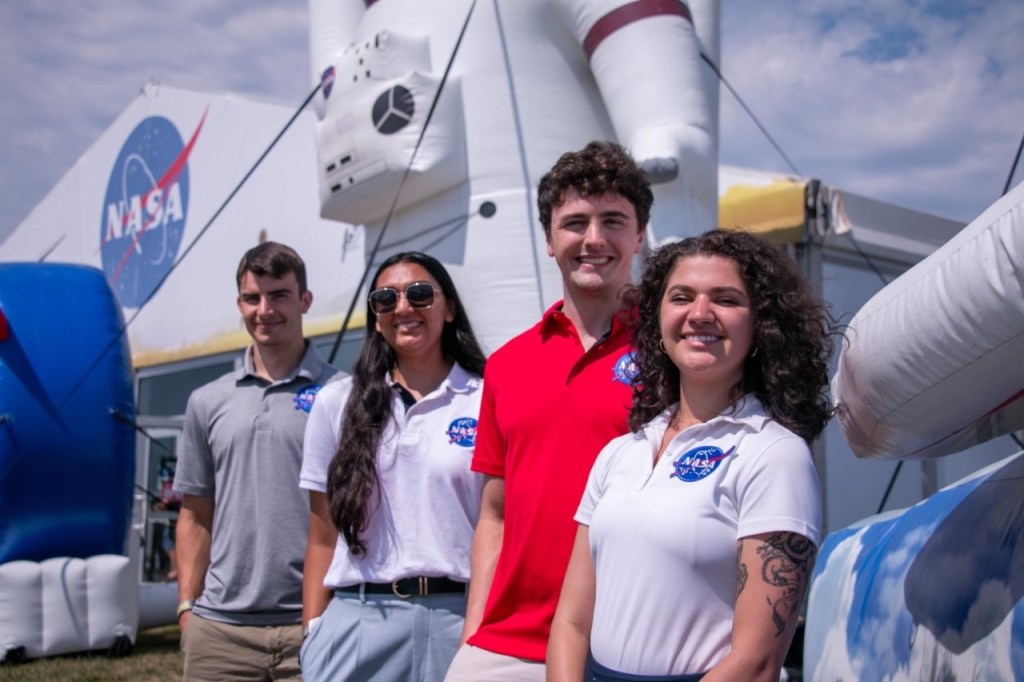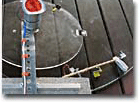A Gravity Assist Mechanical Simulator
This page offers an easily-grasped analog to the gravity assist technique. Explanations and technical references are included.
Instructors and other interested people can build and operate a mechanical device to simulate, remarkably well, what happens when a robotic spacecraft takes advantage of a "gravity assist" on its interplanetary trajectory through the solar system. The device substitutes a strong, moving magnet for a massive orbiting planet, and a steel bearing ball (BB) for a spacecraft. The "magnetic assist" it provides to the BB is closely analogous to the "gravity assist" a spacecraft can receive from a planet moving in its solar orbit.
The participant rolls the BB in an arc on an inclined glass tabletop where it encounters a "Jupiter magnet" revolving around a central image of the Sun. The BB represents a spacecraft on an interplanetary trajectory. As it rolls, slowing, near the top of its arc, the BB can encounter the moving "Jupiter magnet" in such a way it receives an "assist," boosting it higher up the inclined glass surface than it could otherwise have gone.
The image at right shows the "Jupiter magnet" attached near the edge of a clear acrylic disk, driven by a central "Sun motor" that is suspended above the inclined glass tabletop on which the BB rolls.
This simulation device is generally appropriate for the highly motivated high-school science or physics teacher, the lower-level college instructor, or perhaps a group of motivated and savvy students. It's less appropriate for a general audience, since it may require a large number of adjustments and BB launches before a clearly discernible "assist" is obtained.
Learning Objectives:
- Participants will explain how energy can be transferred from a moving mass having a strong attractive force, into a passing object, when they interact via magnetism or gravitation.
- Participants will appreciate the level of precision required to plan and execute an interplanetary flight that achieves a "gravity assist" boost from a planet flyby.
What you'll find on this site:
- A primer describing the "gravity assist" technique for propelling interplanetary spacecraft.
- Complete, illustrated instructions, and parts list with typical sources, for building your own mechanical "gravity assist" simulator.
- Print-ready handouts for participants' use during runs of the "gravity assist" experiment.
Some Assembly Required
This machine requires only a moderate amount of effort gathering and assembling parts, but it does need increasingly fine tuning and calibrating. Building and tuning the machine might take an entire weekend of nearly uninterrupted work, or a week or two given intermittent attention.
One might build this simulator from just a handful of relatively inexpensive parts. The author had to buy only a $2 magnet and some 50¢ bearing balls from the surplus store; the rest of the parts were on hand or borrowed from friends. Tuning and calibrating is necessary because the gravity assist simulation is a subtle interaction. Once tuned up, though, it can easily clarify, in an intuitive way, a subject that is frequently miSunderstood by students, instructors, the press, and even scientists and engineers
For some, just reading and understanding this website might convey the concept well enough, without actually building and running the simulator. Many instructors, however, welcome opportunities to depart from routine classroom activities such as reading, lecturing, and viewing websites in favor of the occasional "hands-on" experiment.
➤ A Gravity Assist Primer
Click above to learn the basics of the gravity assist technique, and find out why it's not really best described as a "slingshot effect."
➤ Build Your Own Gravity Assist Mechanical Simulator
Follow this link for all the information you need to build your own Gravity Assist Mechanical Simulator.
➤ Run Gravity Assist Simulations
Click above for a guide to running Gravity Assist Mechanical Simulations, written in the form of handouts to print for participants to use.
About the simulation runs... After many adjustments, you can get the BB to pass by the revolving magnet at just the right instant to provide an "assist" that clearly changes the BB's trajectory. Some of the "assists" will be downward towards the Sun, decreasing the BB's "orbital" momentum. Some will increase its energy noticeably. Even with careful tweaking and calibrating, this simulator is not able to reliably produce an "assist" in the same manner on every BB launch. It will produce some, and when it does, the "assist" is obvious and intuitively grasped.
Out of 50 BB launches after tuning the release point, you might expect only 2 or 3 outward assists good enough to achieve the "Saturn" target on the glass. The uncertainty adds a bit of suspense and fun. (Of course real interplanetary spacecraft are navigated with much greater precision, without all the uncertainties present in this crude simulation.)
Special thanks to Steve Edberg for work with the original concept, to Diane Fisher, David Seidel, and Charley Kohlhase, for essential comments and additions.
Page updated November, 2016 /
AN AFTER-HOURS PROJECT. NO TAX DOLLARS WERE HARMED DURING THE DESIGN OF THIS SIMULATOR.




























